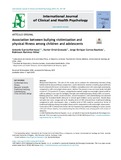Mostrar el registro sencillo del ítem
Association between bullying victimization and physical fitness among children and adolescents
| dc.creator | García Hermoso, Antonio | es_ES |
| dc.creator | Oriol Granado, Xabier | es_ES |
| dc.creator | Correa Bautista, Jorge Enrique | es_ES |
| dc.creator | Ramírez Vélez, Robinson | es_ES |
| dc.date.accessioned | 2021-11-17T13:33:32Z | |
| dc.date.available | 2021-11-17T13:33:32Z | |
| dc.date.issued | 2019 | |
| dc.identifier.issn | 1697-2600 | es_ES |
| dc.identifier.uri | https://hdl.handle.net/2454/41069 | |
| dc.description.abstract | Antecedentes/Objetivo: el objetivo del estudio fue analizar la relación entre el bullying y la condición física, y determinar si un nivel físico saludable está relacionado con menor nivel de victimización en niños y adolescentes con sobrepeso y obesidad en comparación con suscompañeros con sobrepeso u obesidad no aptos. Método: se incluyó un total de 7.714 niños y adolescentes (9-17 años), categorizados en peso normal o sobrepeso/obeso y aptos o no aptos a través de puntos de corte específicos para la capacidad aeróbica y fuerza manual en esta población. El bullying (físico, verbal, exclusión social, acoso sexual y cyberbullying) se evaluó a través de autoinforme. Resultados: los jóvenes categorizados como aptos (capacidad cardio-respiratoria) padecen menos bullying en comparación con sus homólogos no aptos. Además, un nivel saludable de capacidad cardiorrespiratoria se relacionó con menor bullying tradicional entre los jóvenes con sobrepeso/obesidad en comparación con sus homólogos no aptos. Conclusiones: la capacidad cardiorrespiratoria se relaciona con un menor riesgo de sufrir acoso escolar tradicional en los jóvenes latinos con y sin obesidad, lo que enfatiza el papel del buen estado físico incluso entre los jóvenes con exceso de adiposidad. | es_ES |
| dc.description.abstract | Background/Objective: The aim of the study was to analyze the relationship between being bullied and the physical fitness components, and to determine whether a healthy physical fitness level is related with lower victimization in children and adolescents with overweight and obesity compared to unfit overweight/obese peers. Method:The present cross-sectional study included a total of 7,714 youths (9-17 years), categorized as normal-weight or overweight/obese and fit or unfit according to sex-specific handgrip strength and cardiorespiratory fitness (CRF) cut-points. Bullying (physical, verbal, social exclusion, sexual harassment, and cyberbullying) was assessed through the Standard Health Behavior in School-aged Children survey questions. Results:Boys and girls that were categorized as fit (healthy level of CRF) showed lower traditional bullying compared to unfit counterparts. Also, a healthy level of CRF could be a protective factor of traditional bullying among overweight/obese youths compared to unfit overweight/obese peers. Conclusions:CRF is related with lower risk for experiencing traditional bullying in Latino youths with and without obesity, thus emphasizing the role of fitness even among youth with excess of adiposity. | en |
| dc.format.extent | 7 p. | |
| dc.format.mimetype | application/pdf | en |
| dc.language.iso | eng | en |
| dc.publisher | Asociación Española de Psicología Conductual (AEPC) | es_ES |
| dc.relation.ispartof | International Journal of Clinical and Health Psychology, 19 (2), 134-140 | es_ES |
| dc.rights | © 2019 Published by Elsevier Espana, S.L.U. on behalf of Asociación Española de Psicología Conductual. Creative Commons Reconocimiento-NoComercial-SinObrasDerivadas | es_ES |
| dc.rights.uri | http://creativecommons.org/licenses/by-nc-nd/4.0/ | es_ES |
| dc.subject | Capacidad cardiorrespiratoria | es_ES |
| dc.subject | Fuerza muscular | es_ES |
| dc.subject | Bullying tradicional | es_ES |
| dc.subject | Cyberbullying | es_ES |
| dc.subject | Diseño transversal | es_ES |
| dc.subject | Cardiorespiratory fitness | en |
| dc.subject | Muscular strength | en |
| dc.subject | Traditional bullying | en |
| dc.subject | Cyberbullying | en |
| dc.subject | Cross-sectional design | en |
| dc.title | Association between bullying victimization and physical fitness among children and adolescents | en |
| dc.title.alternative | Asociación entre la victimización por bullying y la condición física en niños y adolescentes | es_ES |
| dc.type | Artículo / Artikulua | es |
| dc.type | info:eu-repo/semantics/article | en |
| dc.contributor.department | Ciencias de la Salud | es_ES |
| dc.contributor.department | Osasun Zientziak | eu |
| dc.rights.accessRights | Acceso abierto / Sarbide irekia | es |
| dc.rights.accessRights | info:eu-repo/semantics/openAccess | en |
| dc.identifier.doi | 10.1016/j.ijchp.2019.02.006 | |
| dc.relation.publisherversion | http://doi.org/10.1016/j.ijchp.2019.02.006 | es_ES |
| dc.type.version | Versión publicada / Argitaratu den bertsioa | es |
| dc.type.version | info:eu-repo/semantics/publishedVersion | en |



